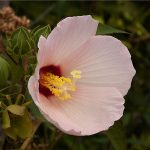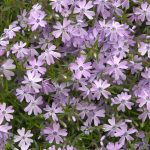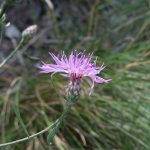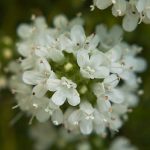Mallow Family: Malvaceae
This often showy, five-petaled flower has a distinctive arrangement of sexual parts with stamens fused around the pistil forming a fuzzy column at the center of the flower. The family includes hollyhock, hibiscus, malva, okra, swamp rose mallow, and cotton. Taxonomists include two subfamilies in Malvaceae, basswood trees and cacao trees, although their flowers do not have fused stamens.
Figwort Family: Scrophulariaceae
Members of this family are distinguished by their slightly irregular flowers with five petals united at the base and two petals pointing upward and three, downward. Also distinctive of this family, once fruit forms, the thread-like style remains attached to the tip of the seed-containing capsule. Family members include butterfly bush, mudwort, figwort, Culver’s root, and mullein.
Hydrangea Family: Hydrangeaceae
We love these family members in our gardens! These shrubs usually have large, dense clusters of showy flowers. Garden varieties have names like PeeGee, Annabelle, oakleaf, mophead, lace cap and come in blues, pinks, whites, pale green, and cream. We love them all! The promiscuous blooms on the outside of the cluster are often sterile, with the action taking place at the center of the cluster. Individual flowers may have four to five petals and the flowers that aren’t sterile may have numerous stamens. Many species are native to eastern, southern, and western states. And many have been “doctored” to meet the demands of gardeners like myself. The family also includes mock orange.
Phlox Family: Polemoniaceae
You can find phlox all over the northeast, from well-groomed gardens to roadside ditches in pale pinks, bright pinks, whites, and magenta. Characteristic of this family are its four or five petals fused to form tubular flowers with flattened faces.
Buttercup Family: Ranunculaceae
Members of the Buttercup family are considered primitive, having characteristics retained from early ancestors. The number of sepals, petals, stamens, and pistils are not fixed and stamens and pistils are arranged in a spiral on a cone-like receptacle as compared to more modern plants with parts arranged in concentric circles and often fused. If you find a flower with many separate pistils, it’s likely in the buttercup family. There are many great garden varieties in the family – anemone, clematis, delphinium, columbine, hellebore, and aconite.
Loosestrife Family: Lythraceae
This family is distinguished by four, six, or eight petals and twice as many stamens as petals. Stamens are in two rings, and each ring of stamens is of a different height. Many members of the primula family have common names containing the word “loosestrife,” but don’t belong to the Lythraceae family.
Verbena Family: Verbenaceae
These family members are easy to confuse with the mint family because of their square stems. But a closer look at the flowers in clusters reveals only slightly irregular flowers with five united petals. The mint family, on the other hand, has characteristic “dragon-head” flowers with two lobes up and three lobes down.
Morning Glory Family: Convulvaceae
Members of the morning glory family are easy to spot — they are vining plants with heart-shaped leaves and funnelform flowers. They can invade and climb over grasses and flowering plants in meadows. The family includes morning glory, bindweed, and sweet potato. Sweet potato plants are often used ornamentally in window boxes. We also eat the sweet potato’s starchy taproot.
Dogbane Family: Apocynaceae
This family contains herbs, shrubs and trees and is distinguished by having leaves that are positioned opposite each other and the plant producing a milky sap. Flowers are tubular with five petals. The family includes periwinkle and, in a subfamily of their own, milkweed and butterfly weed. The flowers of the milkweed subfamily are unusual in shape. Many members also have a corona, or a crown-like addition consisting of five “hoods” that look like petals and face the center of the flower. The five real petals bend backward. Five stamens are fused to the ovary. Once mature, the fruit turns into a large, dry pod.
Family: Clethraceae
This is a very small family, with only two genera, Clethra and Perdieae. Most species are found in the tropics. They are distinguished by being flowering evergreen shrubs or trees, with small, 5-petaled flowers blooming in fragrant clusters along the ends of their branches.
Loving Linneaus
In 1735 the young botanist, Carl Linneaus, published System Naturae, and with its publication, modern botany was born. Originally 11 pages long, he worked on the publication throughout his lifetime. The final, 13th edition was published in 1770 and was over 3,000 pages long.
As a busy collector, Linneaus needed a better, simpler way to identify his specimens. Prior to his work, plants were given long, descriptive Latin names and each name was like a new, unrelated discovery. After completing two expeditions collecting specimens, he was the first to drop the lengthy descriptions and to consistently use two simple words to identify his specimens. He had studied the work of botanists before him, including their naming systems, and had collected, identified, discovered, and thought about so many species that he was beginning to see order where those before him had not. One area he focused on was the flowers of his specimens and he began grouping specimens by the arrangement of their reproductive parts — by counting the numbers of stamens and pistils.
Nightshade Family: Solanaceae
Lots of delicious members in this family including tomatoes, potatoes, and peppers. Family members usually have five united sepals and five united petals with five stamens attached to the petals. Usually herbs, but can be vines or shrubs and leaves may be fuzzy. There are some ornamentals in the family, including the petunia. But some members contain stronger stuff, and can be addictive or cause hallucinations, such as tobacco and belladonna.
Buckwheat Family: Polygonaceae
This family is distinguished by having lots of small flowers in clusters or spikes. Oddly, they typically have five or six sepals that may be colored like petals, but no petals. There are usually three to nine stamens. Seeds are generally triangular. The family includes buckwheat, knotweed, lady’s thumb, smartweed, and rhubarb.
Spiderwort Family: Commelinaceae
These family members are monocots, distinguished from dicots by parallel veins in the leaves and flower parts in multiples of three. A characteristic of this family, leaves wrap around stems and petals often appear sparkly in shades of blue, violet, pink, white, but never yellow. A third petal may be greatly reduced in size. Members of this family usually have six stamens that may differ in appearance.
Borage Family: Boraginaceae
This family is distinguished by five united petals with five stamens attached to the corolla tube. Many members are hairy and create sticky burrs. Flowerheads may curl like a scorpion tail with flowers blooming on the upper surface. The family includes beggarstick, houndstongue, fiddleneck, forget-me-not, bluebell, brunnera, lungwort, and comfrey.
Pink Family: Caryophyllaceae
This family is distinguished by five separate petals often split at the ends. The split may be deep, almost looking like two separate petals as in many chickweeds. The group includes chickweed, Deptford pink, carnation, corncockle, baby’s breath, and soapwort.
St. John’s Wort Family: Hypericaceae
This family has yellow flowers with parts in fours or fives with ten or more stamens, making the center of the flower look fuzzy. It’s not a large family with only three genera found in North America. St. John’s wort, or Hypericum perforatum, comes from Europe and is considered invasive in the Northeast.
Primrose Family: Primulaceae
Primroses are generally herbs or slightly woody plants often found in moist locations. Flowers typically have five petals, five sepals, and five stamens positioned opposite petals. Flowers form in clusters. The family includes pimpernel, primrose, star flower, and loosestrife. But, to keep you on your toes, the family does not include evening primrose and, even though the common name for many members may be loosestrife, they are in the Primrose Family, Primulaceae and not the Loosestrife Family, Lythrum.
Plantain Family: Plantaginaceae
This family is, admittedly, a hodge-podge. Based on genetic evidence, several families were broken apart and recombined to form new groups. As of today, the Plantain Family groups similar flowering plants like snap dragon, turtlehead, butter and eggs, and foxglove with some not-so-obvious relatives such as broadleaf plantain and speedwell.
Pea Family: Fabaceae
Distinguished by five petals taking shape as banner, wings, and keel – one petal with two lobes form the banner, two petals side by side form the wings, and two fused petals form the keel below. They also form distinctive pea pods and usually have pinnate leaves, meaning a single leaf with many leaflets. They are often climbing plants with grasping tendrils and as legumes, important in the nitrogen cycle, converting nitrogen in their underground nodes with help from nitrogen-fixing bacteria into a form of nitrogen plants can use.
Madder Family: Rubiaceae
The Madder family usually has flowers with four united petals and leaves that are positioned either opposite or whorled. You can find them while hiking in the Northeast in meadows and woods – bedstraw, bluets, partridge berry, and button bush.
Poppy Family: Papaveraceae
In the Northeast, these family members are herbaceous plants, but in warmer climates they can be shrubs and small trees. Distinguished by 4, 8, or 12 separate petals. Once the ovary has matured, it forms a distinctive drooping capsule. The family includes poppies and bloodroot.
Rose Family: Rosaceae
This family distinguishes itself with flower parts typically in multiples of five – five sepals, five petals, and at least five stamens. There may be several pistils or compound pistils that give the flower center a fuzzy look. Leaves are generally oval in shape with serrated edges. This is a large family with several sub-families that include roses (of course), raspberries, blackberries, strawberries, quince, and many fruit trees including apple, plum, peach, apricot, nectarine, and almond. And, like the rose, we find many members in our gardens like lady’s mantle and bride’s feathers.
Parsley Family: Apiaceae
So many delicious herbs in this family — parsley, dill, cumin, cilantro, coriander, caraway, carrots, celery, anise, fennel, chervil, and parsnip. Seeds, leaves, stems, and roots may be edible and delicious. The family also includes common meadow and road-side flowers such as golden Alexanders and Queen Anne’s lace. Characterized by their flowers in compound umbels, or umbrella-shaped stalks on umbrella-shaped stalks. But don’t eat all plants with compound umbels — hemlock belongs to this family and is poisonous!
Aster Family: Asteraceae
Daisies, of course! But asters are highly specialized plants – each “flower” is composed of many flowers, usually a ring of sterile ray flowers, each with one large petal on the outside, and many tiny disk flowers on the inside, each with its own tiny petals, stamens, and pistil. Many members of the family have only disk flowers. Each tiny disk flower produces one seed. Think of a sunflower and the disk of seeds that emerges after the petals are gone. Each aster does the same, but usually on a smaller scale. Look closely!
So many examples here that botanists have divided the family into subfamilies and tribes — including chickory, dandelion, thistle, mutisia, boneset, chamomile, marigold, sneezeweed (I’m not making this up), tickseed, and sunflower.
Mint Family: Lamiaceae
So many delicious herbs in this group including spearmint, basil, thyme, rosemary, sage, savory, marjoram, and oregano. Makes me hungry! But the family has other not-so-tasty members common to our gardens and window boxes like coleus, wild bergamot, and lamium. Distinguished by square stalks, opposite leaves, often aromatic, with irregular flowers with five fused petals presenting themselves with two lobes up and three lobes down.











































































































































































































































